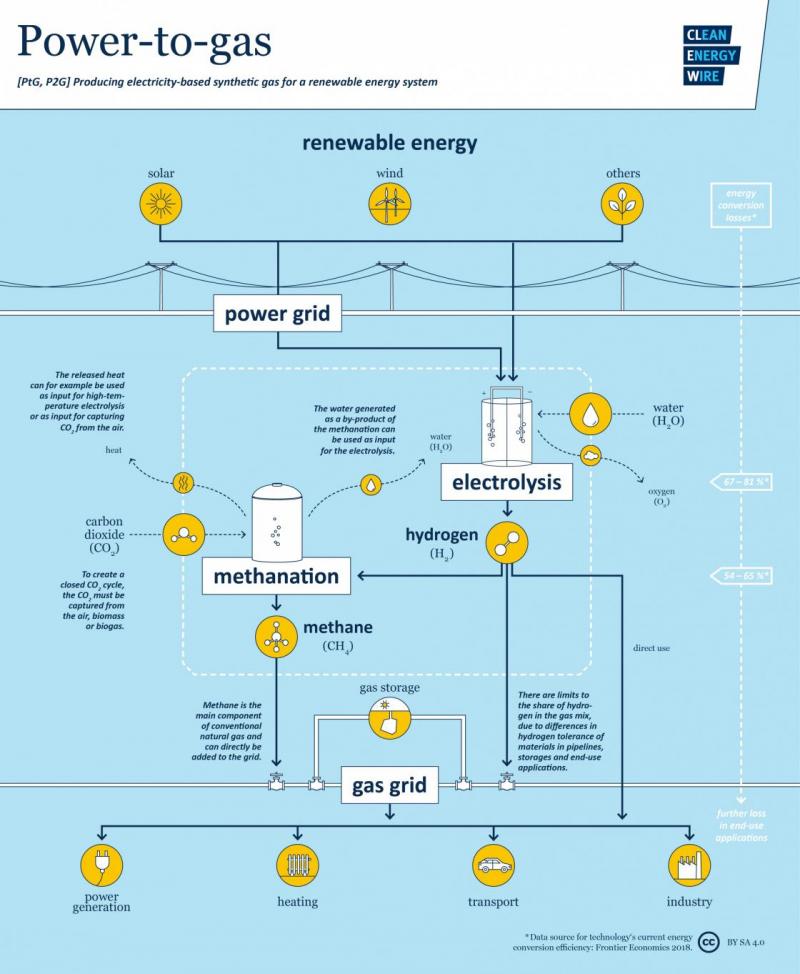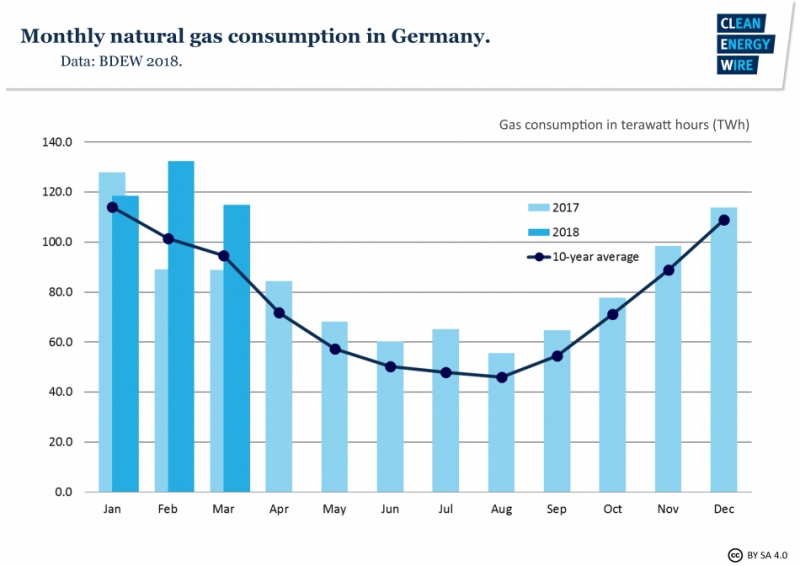Power-to-gas: Fix for all problems or simply too expensive?
The technology
Today, synthetic hydrogen and methane are mostly produced from fossil fuels and biomass. Power-to-gas (PtG/P2G), however, refers to the use of renewable electricity to produce these fuels through electrolysis and methanation. Industry and researchers have struggled to agree on what to call renewable PtG products, using terms such as synthetic gases, wind gas, solar gas, or power-based gases, among others.
The first step in the process is to produce synthetic hydrogen (H2) from water and renewable power via electrolysis. This hydrogen can either be used directly – added to the existing gas mix – or put through a second stage that reacts the H2 with carbon dioxide to produce methane (CH4)
Methane is the key ingredient of natural gas and can be used directly in any of today’s standard gas applications. The CO₂ used in the methanation process is captured from the air, or from biomass or biogas, to ensure a closed carbon cycle. If the carbon dioxide came from a fossil source, as it does in current industrial processes, it wouldn’t count as carbon-neutral.
[download the graphic in full size here]
PtG: Flexible, clean – and expensive
Germany’s biomass potential is limited and the gas industry presents PtG as a kind of all-purpose fix for the challenges of a decarbonised energy system. The energy resulting from PtG is of a high value. Synthetic gas can be used to store energy over long periods of time and transports well. It can be used to create the high temperatures needed in industrial processes and would allow the continued use of existing infrastructure, making extensive modernisation of power plants and appliances unnecessary – saving a lot of money.
At the same time, synthetic fuels have significant disadvantages. A lot of energy is lost during electrolysis, methanation and storage, meaning producing them requires large amounts of renewable energy. After electrolysis, only about 67 - 81 percent of the energy remain, and after the additional step of methanation, only about 54 - 65 percent is left. The production of synthetic fuels is laborious and they will always be more costly and less efficient than direct electricity use.
Storing the summer sun for winter
That’s why some researchers say synthetic gases should only be used when there is no clean alternative. The large-scale, seasonal storage of renewable electricity is one such case.
German energy use is not evenly distributed over the course of a year. During the colder months, heating significantly drives up demand. Wind power production also rises in winter, but solar power is harvested mostly in summer. The electrification of heating, for example by using heat pumps, would replace the seasonal fluctuation of gas consumption with seasonal impacts on the power market.
With current technology, batteries cannot store enough energy in reasonably sized facilities or at an affordable cost to balance out seasonal fluctuation. So Germany currently burns fossil gas in backup plants to meet demand when renewable power generation declines, and will continue to do so in the coming years. Synthetic methane could provide a carbon-neutral alternative from the middle of this century. It could also be used as an alternative to electric heat pumps in buildings where they cannot be installed, such as listed historic buildings.
Replacing natural gas in the industrial sector
Power-to-gas could also be key to the long-term decarbonisation of the industrial sector. It is possible to use electricity to create the high temperatures needed for processes such as steel production. However, industry has employed combustion processes for decades and would need to make significant and expensive changes, while keeping production running. PtG would be the cheaper option; simply using a different, cleaner fuel in standard combustion technology. Hydrogen – currently produced mainly from fossil fuels and used to make ammonia and in the direct reduction of iron ore – could also be made using power-to-gas. And the carbon needed in the chemicals industry, which today mostly comes from oil, could be extracted from synthetic methane.
Germany’s most important industry association, BDI, published its climate path study at the beginning of 2018, concluding that for Germany to achieve its upper target of a 95-percent cut in greenhouse gas emissions by 2050, its entire natural gas supply would need to be replaced with biogas and synthetic gases to avoid emissions from essential industrial combustion processes.
A 2018 meta-analysis by consultancy enervis comparing 10 different studies on the future role of power-to-gas also concluded that the more ambitious Germany is on CO2 reduction, the greater demand will be for PtG.
Scale-up and costs
Many already see PtG as a way to make use of wind power in northern Germany that cannot be transported to areas of high demand in the south due to a shortage of power lines. However, the technology is only up and running in around 30 research and pilot projects in Germany, and these are still far from profitable.
The high cost of PtG means it’s not expected to compete with fossil gas without government support and regulation – such as quotas for the share of synthetic gas in the national energy mix, or a higher price on CO₂ emissions.
For an industrial country like Germany, developing PtG could drive growth. And with pressure on countries around the world to cut fossil fuel use in line with the 2015 Paris Agreement, Germany could benefit from exporting the technology.
But the possibilities of producing synthetic gas itself at home are limited. Power-to-gas facilities are capital-intensive. Even if PtG facilities already existed at the necessary scale, Agora Energiewende and Agora Verkehrswende say not enough excess renewable electricity is currently generated in northern Germany for them to be profitable. Because of high fixed costs, they would need to run at full load as much as possible, the think tanks explain in a study on the future costs of synthetic fuels.
Imports may be needed
Some researchers say Germany will probably have to import significant amounts of synthetic gas in the future. Germany may simply not have space for the number of wind turbines and solar panels needed to produce enough synthetic gas to meet demand, particularly given that German citizens are already resisting the construction of renewable energy infrastructure.
Sun-rich countries may be able to produce it more affordably. For oil countries in North Africa or the Middle East, this could also provide an incentive to move away from fossil-fuel extraction and come on board with international climate protection efforts.
A recent study by the German Energy Agency (dena) predicts Germany importing up to 750 terawatt-hours of synthetic gas and liquid fuels in 2050. Still, higher interest rates and security risks abroad could make synthetic gas produced domestically from North Sea offshore wind competitive.
A draft amendment to the law on the development and support of offshore wind energy currently being debated by government could pave the way for combined facilities in the North Sea that generate wind power and convert it into hydrogen. These facilities would not be connected to the power grid, and so would not have to pay the renewables levy (EEG surcharge). However, according to the draft law, such facilities would be also not eligible for financial support from the government.



